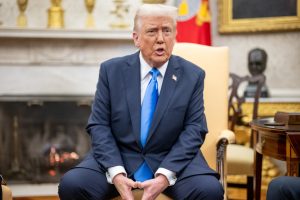The Diplomat author Mercy Kuo regularly engages subject-matter experts, policy practitioners, and strategic thinkers across the globe for their diverse insights into U.S. Asia policy. This conversation with Dr. Ian Ja Chong – associate professor of Political Science at the National University of Singapore – is the 448th in “The Trans-Pacific View Insight Series.”
Identify the top three concerns of Singapore and other Southeast Asian countries regarding U.S. leadership in the region under the Trump 2.0 presidency.
I think the top three concerns would be blanket tariffs, which could hit Southeast Asian economies – especially those who have a trade surplus with the United States, in part because of re-shoring and the “China+1” strategies of various firms. A second concern is likely to be a trade war, most likely between the United States and China, but possibly other major economies as well. The third major concern could be limits on technology exports in the United States and China as well as imports restrictions on each other’s technology by the world’s two largest economies. Such developments could have significant negative effects on economies in Southeast Asia, many of which are trade dependent. They could also create inflationary pressure. Both are likely to create pressure on Southeast Asian governments.
Compare and contrast how the Trump 2.0 administration’s Asia policy will differ from that of the Biden presidency.
The Trump Asia policy seems much less concerned with alliances, institutions, the rule of law, and values. This could suggest U.S. allies might expect less support from Washington and may need to bear more of the burden for maintaining regional stability. This could call into question U.S. commitment to the region. Moreover, the differences in positions among Trump’s Cabinet appointees, including those overseeing economic, security, and foreign policy in Asia, may spell a degree of policy volatility. Regional institutions like ASEAN could face more stress as a result of the developments laid out above.
How might Washington’s geopolitical narrative on China-U.S. strategic competition change under the new U.S. administration?
I do not expect a fundamental shift in position, although there will be less emphasis on values and competition within institutions such as in the United Nations system. That may enable China and Russia to be more effective in reshaping existing international institutions and practices. This means smaller and medium-sized actors may have to rely less on established rules of the game and more on themselves as well as each other if they wish to weather efforts by more powerful actors, including the United States, to simply push through on their preference. There could be some accommodation over trade and investment if Washington and Beijing find sufficient trust that overcomes the incentives of and concerns about reneging after a promise.
Analyze the impact of Trump’s China policy on Southeast Asian countries’ relations with China.
There is a lot of potential variability at this point. Stricter restrictions on China’s exports to the United States and goods that originate from China may open opportunities for Southeast Asian states. However, significant tensions over economics could put regional states under stress as that could diminish their “middlemen” role. Some Southeast Asian states may decide to appease China to gain economic opportunity, despite the fact China’s economy is slowing and facing headwinds. Others may decide to try to seek favor with the Trump administration to permit more favorable terms for economic cooperation and reduce economic exposure to China. A third group may decide to invest more in other economic partners. Under-institutionalization may mean that Southeast Asian responses to the United States and China may have limited coordination, if any.
Assess the future evolution of U.S. regional partnerships and regional groupings, such as the Quad, AUKUS, and IPEF (Indo-Pacific Economic Framework for Prosperity), under Trump’s Asia policy.
I am doubtful IPEF will go anywhere since it is a Biden administration initiative. The Trump administration is also less interested in such types of multilateral frameworks. Trump’s skepticism toward formal arrangements could put some pressure on the Quad and AUKUS, although it also means the other parties may have to work more closely with each other to mitigate the difference in trajectory of the Trump administration.
As described earlier, ASEAN may find responding difficult if it does not reform, so I do not expect major breakthroughs with ASEAN or ASEAN-related initiatives. U.S. alliance relationships may see more of the burden shift toward allies and away from the United States. China may decide to use such openings to press regional states to open themselves more to China’s commercial interests, even though Beijing may now have more financial burdens that qualify its efforts to win partners over through economics. Such conditions may persist until countries find new models for their economies, in ways that may be more insulated from the direct and disruptive effect of any policy from Trump.

































